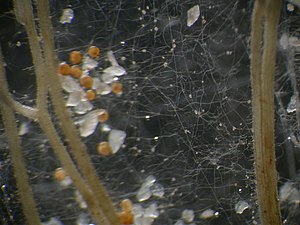Arbuscular mycorrhizal fungi
| Arbuscular mycorrhizal fungi | ||||||||||||
|---|---|---|---|---|---|---|---|---|---|---|---|---|

Gigaspora margarita |
||||||||||||
| Systematics | ||||||||||||
|
||||||||||||
| Scientific name of the department | ||||||||||||
| Glomeromycota | ||||||||||||
| Walker & A. Schuessler | ||||||||||||
| Scientific name of the class | ||||||||||||
| Glomeromycetes | ||||||||||||
| Caval.-Sm. |
The arbuscular mycorrhizal fungi (Glomeromycetes) or AM fungi for short (English arbuscular mycorrhizal fungi , AMF ) are the most common and oldest mycorrhizal fungi. The names VAM or VA mushrooms are still widespread . More than 80% of all land plants have a symbiotic relationship with these fungi. For example, the sweet grasses (Poaceae), like most herbaceous plants, form symbioses with AM fungi. Most lignified plants (seen worldwide) also live in symbiosis with AM fungi .
Formerly, the AM mushrooms were placed with the yoke mushrooms (Zygomycota). Genetic studies have shown that they form a completely separate division of Glomeromycota and are not simply “imperfect” yoke fungi.
Well-known genera of the Glomeromycota are, for example, Glomus and Gigaspora . The largest spores of the Glomeromycota are almost 1 mm in size, the smallest only around 40 µm. Some species sometimes form fruit bodies that can be up to 3 cm in diameter (hypogean fruit bodies) and represent spore clusters or sporocarps.
features
The Glomeromycota live in the ground. Over 200 species are known. Their hyphae are polynuclear and not subdivided by septa . Since the hyphae penetrate the cortical cells of the plant roots, one speaks of an endomycorrhiza (Gr. Endo = inside). The tree-like hyphal formed by the fungi within the root cortical cells are characteristic of the Glomeromycota and hot (from the Latin word arbusculum for sapling) arbuscules . Reproduction takes place via large spores with thick walls, which represent a permanent stage. After germination, the hyphae immediately penetrate the roots of the symbiotic partner. Sexual reproduction is unknown in these mushrooms.
evolution
The emergence of arbuscular mycorrhiza by Glomeromycota can be dated to the Ordovician era, when the first moss-like plants began to colonize the mainland of the earth. AM fungi have probably existed for 900 or even 1200 million years, so they are much older than land plants. In 2013, fossils were discovered in South Africa that were described as 2.2 billion year old "arbuscular mycorrhizal fungi": Diskagma buttonii . At that time, cyanobacteria were a possible symbiotic partner . This possibility is supported by the current existence of a symbiosis of Glomeromycota ( Geosiphon pyriformis ) with cyanobacteria ( Nostoc ), which is the only known endosymbiosis of a fungus with cyanobacteria.
Systematics
According to AMF phylogeny ( LMU Munich ), the Glomeromycota are systematized as follows; the classification was also used in the system according to Hibbet et al. Acquired in 2007. According to Spatafora et al . (2016), the arbuscular mycorrhizal fungi form a subdivision (Glomeromycotina) in the Mucoromycota department together with 2 further subdivisions Mortierellomycotina and Mucoromycotina . However, this classification has not yet been generally recognized.
Kingdom : Mushrooms (Fungi)
Department: AM Fungi (Glomeromycota)
Class : Glomeromycetes
- Order: yoke truffle (Glomerales)
- Family: Jochtrüffelverwandte (Glomeraceae) (at least 1 other family.)
- Genus: Glomus (at least 3 other genera)
- Family: Jochtrüffelverwandte (Glomeraceae) (at least 1 other family.)
- Order: Diversisporales
- Family: Acaulosporaceae
- Genus: Acaulospora
- Genus: Kuklospora
- Family: Entrophosporaceae (belonging to order not yet established)
- Genus: Entrophospora
- Family: Diversisporaceae
- Genus: Diversispora (at least 1 more with 'Glomus' species)
- Family: Gigasporaceae
- Genus: Gigaspora
- Genus: Scutellospora
- Family: Pacisporaceae
- Genus: Pacispora
- Family: Acaulosporaceae
- Order: Archaeosporales
- Family: Archaeosporaceae
- Genus: Archaeospora
- Genus: Intraspora
- Family: Ambisporaceae
- Genus: Ambispora
- Family: Geosiphonaceae
- Genus: Geosiphon
- Family: Archaeosporaceae
- Order: Paraglomerales
- Family: Paraglomeraceae
- Genus: Paraglomus
- Family: Paraglomeraceae
As one can easily see, the preceding system, which is largely based on a molecular phylogeny , is still somewhat temporary. The genus Glomus is still polyphyletic, which means that it did not emerge from a common ancestor. A further change in the system based on more recent gene-based studies is to be expected.
Demarcation
The genus Endogone (a typical representative of the yoke mushrooms ), which used to belong to the yoke truffle-like species, has nothing to do with the Glomeromycota or the Glomeromycetes or the Glomerales.
Individual evidence
- ^ BT Goto & LC Maia (2005). Sporocarpic species of arbuscular mycorrhizal fungi (Glomeromycota), with a new report from Brazil . Acta Botanica Brasilica, 19 (3), 633-637. doi : 10.1590 / S0102-33062005000300025 .
- ^ Joachim W. Kadereit, Christian Körner, Benedikt Kost, Uwe Sonnewald: Strasburger - Textbook of Plant Sciences . Springer, Berlin / Heidelberg 2014, ISBN 978-3-642-54435-4 , pp. 553 f ., doi : 10.1007 / 978-3-642-54435-4 .
- ↑ https://www.researchgate.net/profile/Michael_Krings/publication/316511975_Early_fungi_Evidence_from_the_fossil_record/links/59744396458515e26dfdfb38/Early-fungi-Evidence-from-the-fossil-record.pdf
- ↑ https://cpb-us-e1.wpmucdn.com/blogs.uoregon.edu/dist/d/3735/files/2013/07/Retallack-2014-Precambrian-life-on-land-zt5d7e.pdf
- ↑ DS Hibbett et al .: A higher-level phylogenetic classification of the Fungi . In: Mycological research , May 2007; 111 (5): 509-547. Epub 2007 March 13, 2007. PMID 17572334
- ↑ Joseph W. Spatafora, Ying Chang, Gerald L. Benny, Katy Lazarus, Matthew E. Smith, Mary L. Berbee, Gregory Bonito, Nicolas Corradi, Igor Grigoriev, Andrii Gryganskyi, Timothy Y. James, Kerry O'Donnell, Robert W. Roberson, Thomas N. Taylor, Jessie Uehling, Rytas Vilgalys, Merlin M. White & Jason E. Stajich .: A phylum-level phylogenetic classification of zygomycete fungi based on genome-scale data. In: Mycologia . tape 108 , no. 5 , 2016, p. 1028-1046 , doi : 10.3852 / 16-042 ( pdf ).
- ↑ amf-phylogeny.com. Retrieved May 3, 2018 .